Spiny McSpleen's Nifty

Webpage
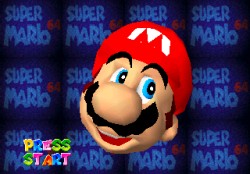
Released in 1996 as a launch title for the Nintendo 64, Super Mario 64 was the very first 3D Mario game. As soon as the game started up, players were almost immediately immersed in Mario 64's dynamic 3D environment, able to move Mario anywhere within it. It became a million-seller within a few short months of release, sending the Nintendo 64 console rocketing past the Sony PlayStation in total sales. Almost fifteen years later, Super Mario 64 is still quite popular, even with new gamers. With two iterations on two different consoles and game developers still using its game engine, it's not difficult to understand why Super Mario 64 is the niftiest game in the Mario series.
STORYLINE
Super Mario 64 begins with a letter sent to Mario by Princess Peach, inviting him to the castle for a piece of cake. When Mario arrives, a voice that bears a marked resemblance to Koopa tells Mario to "scram". Upon further investigation, Mario discovers that all but one of the palace rooms are locked. Mario finds Toad, who informs him that Koopa has stolen all of the castle's Power Stars and has locked all of the Toads inside the palace walls. Entering the unlocked room, Mario discovers a large painting of a Bob-Omb, which he finds to be a portal to another world.
The game was criticised for its uncreative plotline, inasmuch as it involves Koopa raiding the Mushroom Palace and kidnapping the princess, similar to many other games in the series. However, the same critics also said that what Mario 64 lacked in storyline, it vastly made up for in gameplay.
GAMEPLAY
The game begins with Mario standing in the castle's front garden. In this area, the player is presented with a chance to test all of Mario's new moves. In previous titles, Mario only had two very basic moves -- run and jump. Super Mario 64 introduced combat moves (punching and kicking) and swimming moves (breast-stroke and flutter-kick). Nintendo also built upon the two basic moves from past titles. Mario could now attain different heights by jumping, then jumping again as he landed. Backflips and Wall-Kicks were introduced, as well as a move called "pound the ground", which could be executed by crouching in the middle of a jump.
Unlike past Mario titles, where Mario moved in the direction indicated by the controller's directional pad, Mario's movement was now controlled by a control-stick. With the directional pads of yore, the button was either being pressed or it wasn't being pressed, allowing Mario only one speed. With the control-stick, the player could ease the stick in some direction, allowing Mario a full range of running, walking, and sneaking speeds. If the control-stick was pressed all the way to the end, Mario would run quickly. If the control-stick was barely being pressed, Mario would walk quietly on tip-toe. In between these two speeds was a strolling walk speed.
The world contains numerous items that Mario can use, many of which will make him almost completely invincible.
The most well-known items were the Power Caps. After Mario pressed a switch in a secret course, Cap Blocks of the same colour as the switch would turn solid, allowing Mario access to one of three Power Caps. The Wing Cap allowed Mario to fly and to float to the ground slowly if he fell from a height before he could take off. The Vanish Cap turned Mario invisible, allowing most enemy attacks to pass harmlessly through him. The Metal Cap turned Mario into metal, which made him invulnerable to enemy attacks and would also cause enemies to bounce off if they touched him.
Another usable item was the Koopa Shell, which Mario could ride like a skateboard. Koopa shells could be taken from Koopa Troopas or found in yellow item boxes. Less often, Koopa shells could be found lying about. If Mario used a Koopa shell on land, he could damage enemies by running into them and could ride over bodies of water. If Mario used a Koopa shell in the water, he could move faster than normal, but the shell would disappear after a short time or if he ran into an enemy or obstacle.
Yellow item boxes would also contain coins and 1-Up Mushrooms
ENVIRONMENT
The environment in Super Mario 64 was completely 3-dimensional. Coupled Mario's full range of motion, players could now explore every inch of the world. In the world, Mario would encounter poles or trees that could be climbed, monkeybars, or tall walls that could be climbed only by Wall-Kicking, among other things.
STAGES
There were 15 main areas in Super Mario 64, each with six normal stars and one secret star. Some courses would contain hidden courses that also held a star. The castle, itself, also contained hidden areas, such as slides or Power Cap Switches. In total, there are 120 Power Stars in the game (90 regular stars, 30 secret stars).
Mario 64 is considered to be a "sandbox" game, as it will allow the user to continue playing even after the end has been reached (albeit, requiring a restart of the console). Although not the first Mario game to do this (the first being Super Mario World in 1991), simulator games such as SimCity were the most well-known for being "sandbox" games up to this point. When all 120 stars have been retrieved, the player may choose to fight Koopa for the final time and see the credits screen, or the player may decide to return to any area and replay certain missions (even if the player chooses to fight Koopa, after the credits roll, restarting the console will allow them to continue play). Adding to the replay value are certain rewards that are unlocked after all stars have been found. A cannon will open in the castle's front garden, allowing access to the castle roof; Yoshi, who can be found on the roof will provide Mario with 100 extra lives, as well as an enhanced triple-jump that stops Mario taking damage if he triple-jumps from a height. The "play forever" aspect of Mario 64 almost certainly contributed to its success.
After Mario 64's success, many other games across all platforms imitated its "sandbox" gameplay (well-known examples on the Nintendo 64 include GoldenEye 007, Banjo-Kazooie, and The Legend of Zelda: Ocarina of Time).
MUSIC & VOICE
Koji Kondo (veteran Mario and Zelda composer) scored Super Mario 64. Much of the soundtrack was based on a single theme, called the "Super Mario 64 Main Theme" or "Overworld Theme" among gamers and MIDI enthusiasts (which can be heard in Bob-Omb Battlefield, among other courses). Like The Legend of Zelda: Ocarina of Time after it, Super Mario 64 is well-known for introducing particular musical phrases into common Mario game scoring. Just as Ocarina of Time introduced "Saria's Song" and the "House" themes (among others), Mario 64 introduced a theme for Princess Peach (the song heard inside the palace) and Toad (the musical sting played when Mario interacts with Toad).
Only two voice-actors were needed for the in-game dialogue -- they were Charles Martinet (voicing Mario) and Leslie Swan (voicing Peach). Charles Martinet had, in fact, been Nintendo's official Mario voice since 1990, though this was the first major Mario platformer where Mario's voice could be heard. He has been the voice of not only Mario, but Luigi, Wario, Waluigi, Baby Mario, Baby Luigi, and Toadsworth (introduced in Super Mario Sunshine) ever since.
Leslie Swan was the game's English-language text-writer and only performed Peach's voice twice after Mario 64 (in Mario Kart 64 and Super Mario 64 DS). Beginning with Mario Golf in 1999, she was replaced by Jen Taylor as Peach's voice.
RUMOURS
Super Mario 64 was released at the same time that the Internet was gaining popularity. To that end, many websites became Mario 64 rumour-mills -- screenshots of the game were being doctored to make it seem as though the game could do more than it actually can -- hundreds of Power Stars, thousands of coins, more stages than were actually in the game. The fastest-spreading rumour, however, involved Luigi. Some websites contended that Luigi could be found in one of the courses after all stars had been found. At this point, the player could switch off with him and play as Luigi. Others held that Luigi would follow Mario about for some reason. Numerous doctored screenshots of Mario 64 with Luigi in them surfaced -- some with Luigi in place of Mario, others with Luigi alongside Mario.
In 2009, Shigeru Miyamoto finally revealed in an interview that two-player functionality had been planned for Mario 64, in that one player would control Mario and the other would control Luigi. The screen would be split down the middle and the players would control their characters independently of each other. Miyamoto-san provided no other information on this point beyond, "We couldn't pull it off."
GameShark
The game was second only to GoldenEye 007 in popularity with hackers. Much of the game's behaviour has been modified in some way by a hacker at some point in time. Using a GameShark, one could give Mario superhuman abilities, such as moon-jumping, invincibility, and immunity to drowning; or bizarre abilities that would normally be construed as programming errors, such as walking on his head, taking heavy damage from jumping, or making his torso disappear.
As it was becoming apparent that Luigi was, in fact, not in Super Mario 64, hackers began making Mario into Luigi by altering the hexadecimal colour values used to colour Mario's outfit. Such a code can be found further down the page.
SUPER MARIO 64 DS
In 2004, a re-make of Super Mario 64 (called Super Mario 64 DS) was released alongside the Nintendo DS console. The original game had been built upon and now included 30 additional Power Stars, more secret levels in which to locate them, and three other characters that the player may choose from (Luigi, Wario, and Yoshi) to use in place of Mario. Also introduced were Mario-related mini-games which could be unlocked by catching rabbits.
OTHER RELEASES
Super Mario 64 has seen two other iterations. The first was a re-release in Japan for the Nintendo 64DD that included Rumble Pak support. The second was a release of the original game for Wii Virtual Console.
GameShark CODES
Mario Recolours
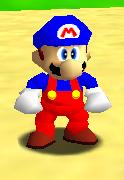
Arcade Mario
8107EC42 FF00
8107EC3A AA00
8107EC40 0000
8107EC38 0000
8107EC20 AA00
8107EC22 0000
8107EC28 FF00
8107EC2A 0000
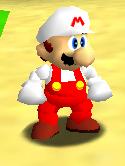
Fire Mario
8107EC40 FFFF
8107EC42 FF00
8107EC38 9999
8107EC3A 9900
8107EC20 9900
8107EC22 0000
8107EC28 FF00
8107EC2A 0000
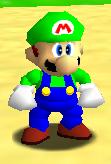
Luigi
8107EC38 007E
8107EC40 00FF
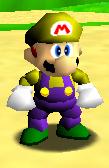
Wario
8107EC40 FFFF
8107EC42 0000
8107EC38 0000
8107EC3A 0000
8107EC20 0000
8107EC22 0000
8107EC28 9933
8107EC2A FF00
8107EC70 0099
8107EC72 0000
8107EC68 0000
8107EC6A 0000
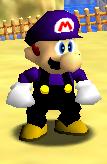
Waluigi
8107EC40 5401
8107EC42 BA00
8107EC38 0000
8107EC3A 0000
8107EC20 0000
8107EC22 0000
8107EC28 0000
8107EC2A 0000
8107EC70 FFCC
8107EC72 0000
8107EC68 0000
8107EC6A 0000
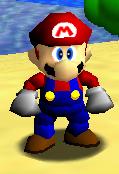
Enhanced Mario
8107EC38 0000
8107EC3A 0000
8107EC20 0000
8107EC22 0000
8107EC50 0000
8107EC52 0000
8107EC68 0000
8107EC6A 0000
8107EC98 0000
8107EC9A 0000
TRIVIAL INFORMATION
There are 2,041 coins in total to be found in the game.
The appearance of the red, green, and blue Switches is a reference to Super Mario World, the previous Mario platformer for the Super Nintendo.
The Wing Cap Switch course is the only one of the three that does not involve the castle moat in some way. The Metal Cap switch course supposedly supplies the water for the moat, access to which is down the opposite end of the cavern from the switch. The Vanish Cap switch course is located underneath the moat, itself.
Also, there are two courses inside the castle (one numbered and one secret) that exit onto the moat. Course #9, "Dire Dire Docks", allows one to exit to the moat through the submarine door. The secret course, "Wing Mario Over the Rainbow", will send one falling into the moat if one falls off the side of a platform.
Courses 3 and 9 (Jolly Roger Bay and Dire Dire Docks) both have levels called "Through the Jet Stream", both involving stars obtainable only through the usage of a Metal Cap. However, Dire Dire Docks requires Mario to swim through five rings before the star appears, where the star at Jolly Roger Bay is always present.
The antechamber to Course #13: Tiny-Huge Island was intended to create an optical illusion. If one were to stand at the very end of the "huge" corridor and look in the direction of the "tiny" corridor, one would get the visual effect of one very long corridor between two equally-sized paintings.
There are three courses whose names have double words. They are Course #4: Cool Cool Mountain, Course #9: Dire Dire Docks, and Course #12: Tall Tall Mountain.
Super Mario 64 was one of two launch-titles for the Nintendo 64. The other was Pilotwings 64.
Super Mario 64 was originally planned as a Super NES game to be called Super Mario FX (so named for the FX Chip that allowed the console to display 3D objects). During development of Super Mario FX, however, Shigeru Miyamoto decided that the game would do better on their new Ultra 64 system (later renamed "Nintendo 64").
While most of the courses in the game are vast 3D environments, the 14th and 15th courses (Tick-Tock Clock and Rainbow Ride) and the three Koopa levels are drastically more linear. This was because these courses were designed while Mario 64 was still being developed for the Super NES, as the FX Chip could only handle limited 3D display. Later on, the 14th and 15th courses were given extra areas to make them seem less linear, but the designs for the Koopa levels remained relatively unchanged -- programmer Giles Goddard said that they were kept linear so as to force players into Koopa's lair, rather than to encourage exploration.
During the height of the Luigi rumours, IGN offered a bounty of 100 US Dollars to the person who could prove that Luigi was in the game in some capacity. The Luigi rumours have since been proven completely untrue. Hackers have reported that there are no aspects of the game that have not been accounted for in the source code. Bluntly, Luigi is not in Super Mario 64.
For a time in 1998, there was a rumour about Wario being in Super Mario 64 as well. According to this rumour, after all 120 stars had been found and the cannon in the castle's front garden had been opened, the player could use the cannon to shoot through the castle's stained-glass window. Landing in the mezzanine, the player would then be confronted by Wario. It is unclear, however, what purpose Wario was said to have served at this point. This unpopular rumour subsided after a few months.
Isaac Marshall, the voice of Koopa and the Thwomps, is not given credit in the staff-roll. Marshall would reprise those roles in Mario Kart 64, along with providing the voice of Donkey Kong.
Over 30 courses were planned for the game, but only 15 made it into the final build. Some courses were scrapped completely, some made it into other titles on the Nintendo 64 and GameCube.
The Mario Face screen was based on the digital puppet, "Mario in Real Time", which is used by Nintendo at tradeshows. Charles Martinet started voicing Mario for the first such presentation in 1990.
The Super Mario 64 game engine has been re-used numerous times. In fact, the one used in The Legend of Zelda: Twilight Princess can be traced back to it (having made use of parts of the Ocarina of Time game engine, which was a derivative of Mario 64's).
Though Mario 64 was the first Mario platformer where Charles Martinet's Mario voice was heard, the first game, in general, was called Mario's FUNdamentals (also called Mario's Game Gallery).
In an interview with Famitsu magazine in 1991, Shigeru Miyamoto said, "I don't know what Mario will look like next; maybe he will wear metallic clothing." One of Mario's transformations in Super Mario 64 is into a metal form.
The number, three, makes many appearances in Super Mario 64...
There are three Koopa's Road courses, and three subsequent fights with Koopa.
The Big Bob-Omb, Whomp, Big Boo, and Wiggler can all be defeated in three hits.
There are three Power Cap Switch courses, and three subsequent Power Caps.
Wooden stakes can be driven into the ground by pounding them three times.
In Course #5: Big Boo's Haunt, Mario must fight Big Boo three times.
There are 120 stars in total -- a number which is divisible by three and one that also comes out to three when added to itself (1 + 2 + 0 = 3).
There are six named stars in every course, a number which is divisible by three.
Mario's highest jumping height is attained by jumping three times in sequence.
Mario has three basic combat moves: a right hook, a left hook, and a kick.
There are 15 regular courses in the game, a number which is divisible by three (30 courses were originally planned for the game, which is also divisible by three).
There are certain ways for Mario to be damaged which take three segments away from his Power Metre.
There are three Mushroom Retainers (Toads) in the palace who are in possession of stars.
The mirror in the antechamber to Course #10: Snowman's Land is split into three segments.
There are three courses whose names contain double words (see above).
There are three zoom levels to the in-game camera.
Excluding the Boo with the entrance to Course #5: Big Boo's Haunt, there are three groups of three Boos in the castle courtyard.
There are three Mushroom Retainers on the palace mezzanine.
In the antechamber to Course #13: Tiny-Huge Island, there are three of the same picture on the wall down three different corridors in three different sizes.
Three is the required number of stars needed to open certain doors.
There are three stained-glass windows in the antechamber to The Princess's Secret Slide.
The palace has three exits: the main doors, the door under the moat, and the courtyard door.
There are three of the same painting in the antechamber to Course #3: Cool Cool Mountain.
There are three 1-Up Mushrooms on the palace roof.
PICTURE GALLERY



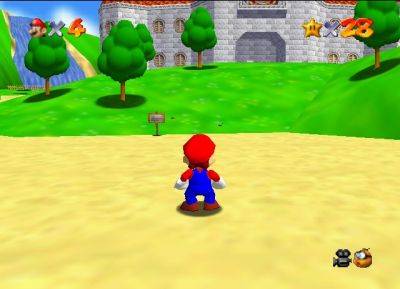
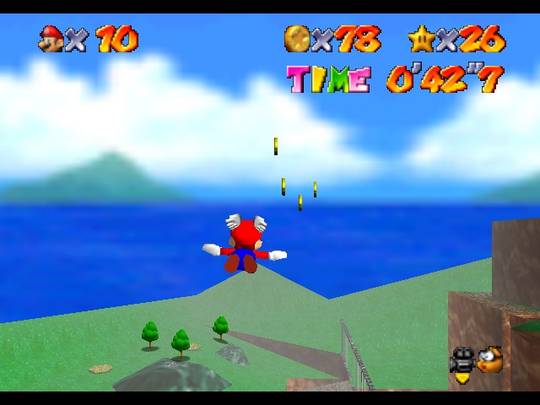
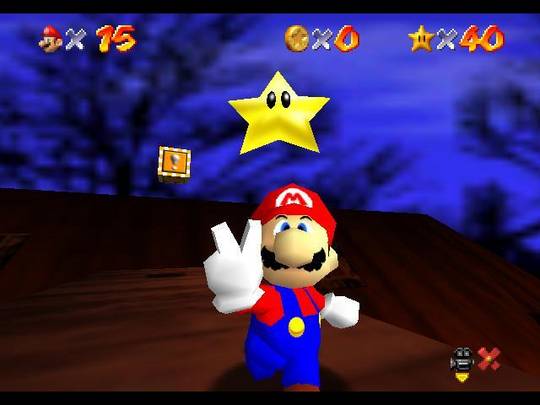
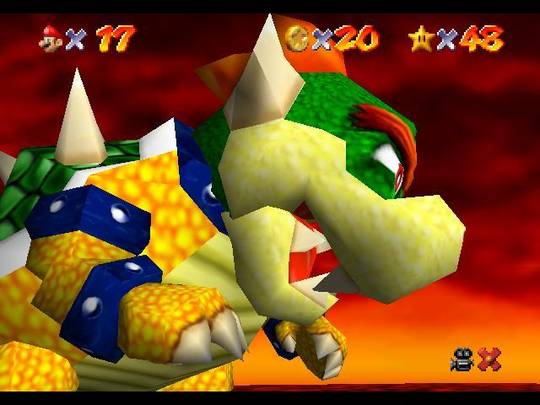
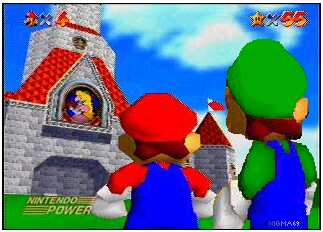
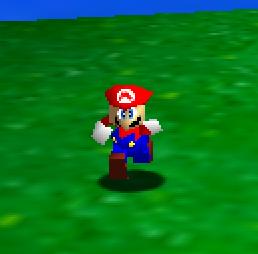
RELATED LINKS
"Super Mario 64" on Wikipedia
Super Mario 64 gameplay example with full intro and title screen
Spiny McSpleen's Nifty Mario Page
Nintendo Official Site
HOME
Copyright © 2009 SebasTECH, Ltd. Page coding and layout by J. Sebastian Perry (A.K.A. Spiny McSpleen)




















